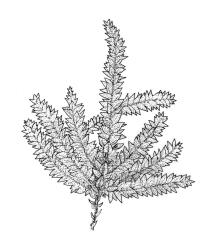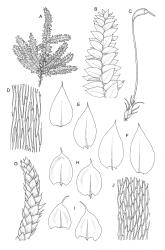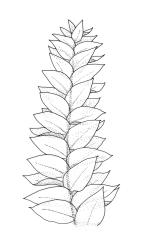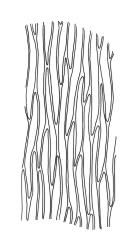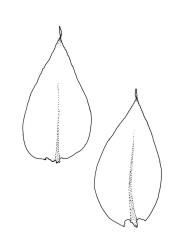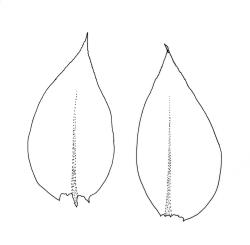- ≡ Hypnum tenuifolium Hedw., Sp. Musc. Frond. 283 (1801)
- = Hypnum huttonii Hampe ex Beckett, Trans. & Proc. New Zealand Inst. 25: 300 (1893)
Plants medium-sized, bright or pale green, lustrous when dry. Stems irregularly or subpinnately branched, from <40–100 mm or more, not or weakly complanate. Branches ascendant and variably complanate. Stem and branch leaves differing only by size, not striolate when moist or dry. Stem leaves broadly ovate, abruptly and shortly acuminate, asymmetric at base, spreading, not complanate, mostly (1.6–)1.8–2.0 × c. 1.0 mm, narrowed and ± cordate at base, plane at margins, margins sharply denticulate nearly to base; mid laminal cells linear, 90–120(–135) × 6–9 µm, becoming shorter and broader near base; cells of the acumen not differentiated but somewhat shorter; cells at insertion shorter, thicker-walled and porose in several rows; alar cells not differentiated. Branch leaves smaller and more complanate than stem leaves but not otherwise differentiated, mostly 1.5–1.6(–1.8) × 0.65–0.8 mm. Costa rapidly tapered, not forked, extending c. ½–⅔(–¾) to apex, lacking or rarely with a terminal abaxial spine.
Perichaetia c. 2.0 mm long, the inner leaves acuminate from an oblong base, erect or weakly spreading. Perigonia scattered on stems & branches, c. 0.8 mm, with filiform paraphyses. Seta nearly straight, smooth, red-brown, c. 15–20 mm; capsules oblong-cylindric, red-brown, constricted below the mouth when dry, 1.6–2.0 mm; exothecial cells mostly oblong, firm-walled, weakly collenchymatous; annulus not clearly seen; operculum ± equal the theca. Exostome teeth as per genus, finely transversely striate on the outer surface, c. 450 µm; endostome as per genus, with perforate segments and single or paired, nodose cilia. Spores 12–14 µm.
Beever et al. 1992, fig. 78 a–e; Hedenäs 2002, fig. 11 c–d; Malcolm & Malcolm 2003, p. 59; Meagher & Fuhrer 2003, p. 79.
When well developed, the lustrous, non-striolate, and complanate plants facilitate recognition of R. tenuifolium. Sporophytes are frequently present in this autoicous species, and the presence of the asymmetric oblong-cylindric capsules with long-rostrate opercula is useful in its recognition. However, less well-developed material can be confused with R. laxatum; mixtures of the two species are frequent and can be confusing.
Sterile Brachythecium rutabulum is sometimes confused with R. tenuifolium. Rhynchostegium tenuifolium is a less robust plant with smaller leaves (stem leaves 1.6–2.0 vs 2.5–3.0 mm), in which the branches are distinctly complanate. The most easily observed gametophytic difference, however, is the absence of differentiated stem leaf decurrencies in R. tenuifolium. Numerous sporophytic characters also distinguish the two species, but confusion is far less likely when fruit is present.
K; NI: N Auckland including offshore islands (TK, PK, HC, LB, GB), S Auckland, Gisborne, Hawke’s Bay, Taranaki (Lake Rotokare, New Plymouth, Stratford), Wellington; SI: Nelson, Marlborough, Canterbury, Westland, Otago, Southland; St; Ch; Sol; C.
Austral. Tasmania*, mainland Australia*. Reported from South America by Scott & Stone (1976, p. 430) and others.
On decaying wood, exposed roots, tree trunks, and sometimes branches of a wide range of native and introduced tree species, including tree ferns. Also terrestrial on humus, duff, or soil and sometimes growing on thin soil over rock (breccia, granite, greywacke, limestone). On the North I. occurring from sea level (many localities) to at least 780 m (Erua, Wellington L.D.). On the South I. ranging from near sea level (many localities) to at least 735 m (Banks Peninsula).
In keeping with its varied habitats, R. tenuifolium can associate with a large number of moss taxa, including Achrophyllum spp., Calomnion complanatum, Calyptrochaeta flexicollis, Hypopterygium sp., Hypnum cupressiforme, Lembophyllum divulsum, Racopilum convolutaceum, Rhaphidorrhynchium amoenum, Rhizogonium distichum, Thuidiopsis furfurosa, and Wijkia extenuata.
The typification of Hypnum huttonii Beckett poses some difficulty. Although three of the four specimens cited by Beckett (1893, p. 300) are present in the Beckett herbarium, they include two species of Rhynchostegium as well as Eriodon cylindritheca. The lectotype selected above conforms with both Beckett’s diagnosis and with Dixon’s (1929, p. 328) placement of this name in the synonymy of R. tenuifolium.



